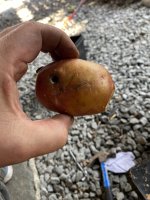D
Deleted user 6789345
The potato (Solanum tuberosum) originated in the Andean region of South America, where it was domesticated by indigenous peoples around 8,000 to 10,000 years ago. It was brought to Europe by Spanish explorers in the late 16th century. From there, its spread to the northern countries of Europe and other parts of the world followed over the subsequent centuries.
In northern Europe, the potato was introduced in the 17th century, but its adoption was slow. The initial resistance stemmed from a variety of factors, including unfamiliarity, suspicion about its safety, and concerns over its cultivation.
**Ireland:**
The potato found a more welcoming environment in Ireland around the late 16th century, where it became a staple by the 18th century. The country's cool, moist climate suited potato farming, and the crop's ability to yield a high caloric output from a small area of land made it particularly valuable.
**Great Britain:**
In Great Britain, the potato's popularity increased in the 18th century, although it was initially regarded with skepticism. Agrarian reformers like Sir Walter Raleigh and Sir Francis Drake played roles in promoting its use, and by the end of the century, the potato had become an important food source, particularly among the working class.
**Scandinavia:**
In Scandinavia, the potato's acceptance was gradual. It was introduced to Sweden and Denmark in the early 18th century. In Sweden, Jonas Alströmer, a notable agricultural reformer, is credited with promoting its cultivation. By the late 18th century, the potato was established in the region as a vital food source, particularly during periods of grain shortages.
**Germany:**
Germany also saw a gradual acceptance of the potato. Frederick the Great of Prussia, in the mid-18th century, was a significant advocate for the potato, recognizing its potential to improve food security. He implemented policies to encourage its cultivation, including distributing seed potatoes and instructing farmers on their cultivation.
**Russia:**
The potato reached Russia in the 18th century, but its adoption was particularly slow, hindered by peasant resistance and mistrust. It wasn't until the 19th century, under Tsar Nicholas I, that the government began to seriously promote potato cultivation as part of efforts to modernize agriculture and ensure food security.
In summary, the potato's journey to the northern countries of Europe was marked by initial resistance but eventual acceptance, driven by the efforts of agricultural reformers and the undeniable benefits of this highly productive crop. By the 19th century, the potato had become a staple food in many of these regions, profoundly influencing their diets and agricultural practices.
CIRCLE OF LiFE
In northern Europe, the potato was introduced in the 17th century, but its adoption was slow. The initial resistance stemmed from a variety of factors, including unfamiliarity, suspicion about its safety, and concerns over its cultivation.
**Ireland:**
The potato found a more welcoming environment in Ireland around the late 16th century, where it became a staple by the 18th century. The country's cool, moist climate suited potato farming, and the crop's ability to yield a high caloric output from a small area of land made it particularly valuable.
**Great Britain:**
In Great Britain, the potato's popularity increased in the 18th century, although it was initially regarded with skepticism. Agrarian reformers like Sir Walter Raleigh and Sir Francis Drake played roles in promoting its use, and by the end of the century, the potato had become an important food source, particularly among the working class.
**Scandinavia:**
In Scandinavia, the potato's acceptance was gradual. It was introduced to Sweden and Denmark in the early 18th century. In Sweden, Jonas Alströmer, a notable agricultural reformer, is credited with promoting its cultivation. By the late 18th century, the potato was established in the region as a vital food source, particularly during periods of grain shortages.
**Germany:**
Germany also saw a gradual acceptance of the potato. Frederick the Great of Prussia, in the mid-18th century, was a significant advocate for the potato, recognizing its potential to improve food security. He implemented policies to encourage its cultivation, including distributing seed potatoes and instructing farmers on their cultivation.
**Russia:**
The potato reached Russia in the 18th century, but its adoption was particularly slow, hindered by peasant resistance and mistrust. It wasn't until the 19th century, under Tsar Nicholas I, that the government began to seriously promote potato cultivation as part of efforts to modernize agriculture and ensure food security.
In summary, the potato's journey to the northern countries of Europe was marked by initial resistance but eventual acceptance, driven by the efforts of agricultural reformers and the undeniable benefits of this highly productive crop. By the 19th century, the potato had become a staple food in many of these regions, profoundly influencing their diets and agricultural practices.
CIRCLE OF LiFE



